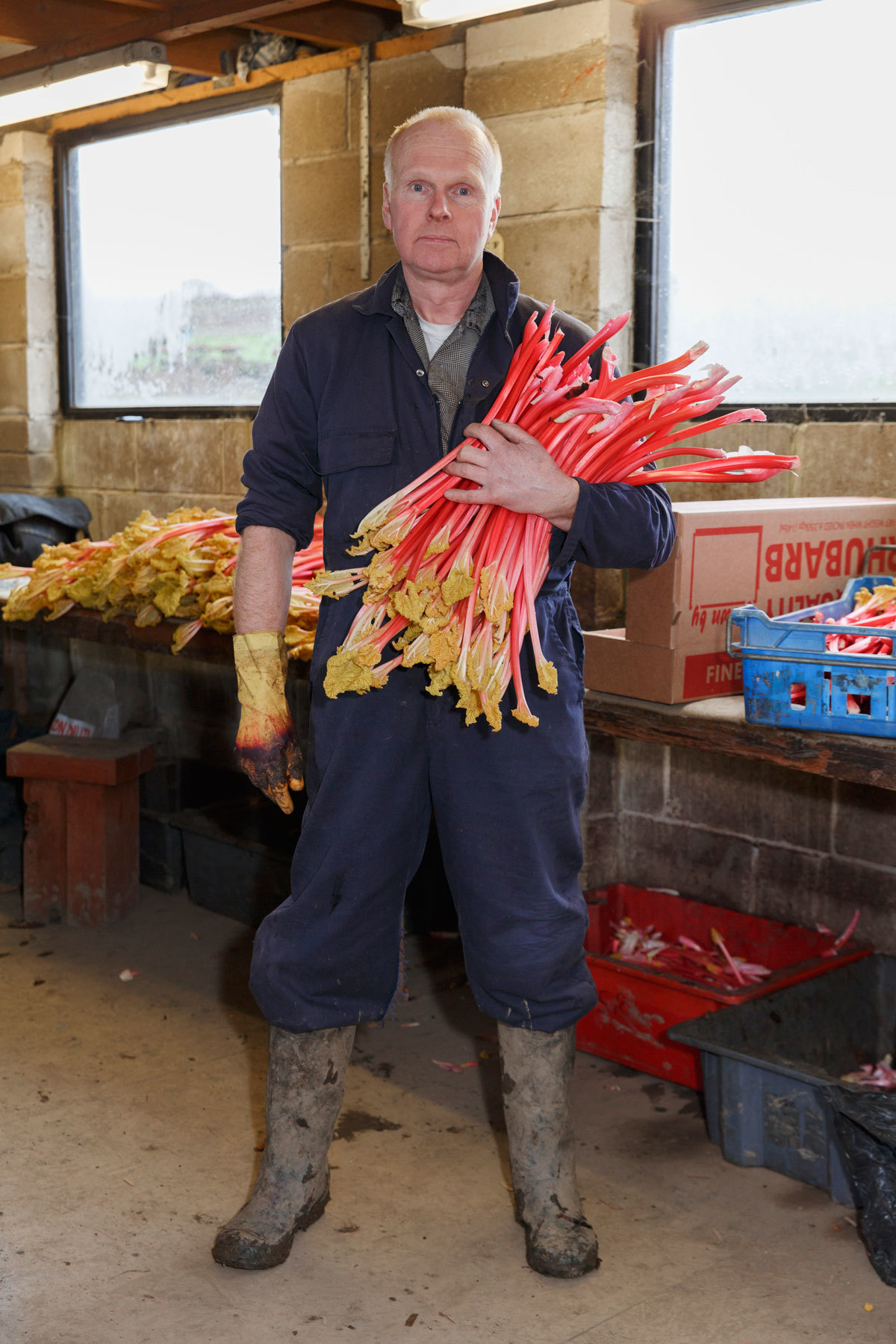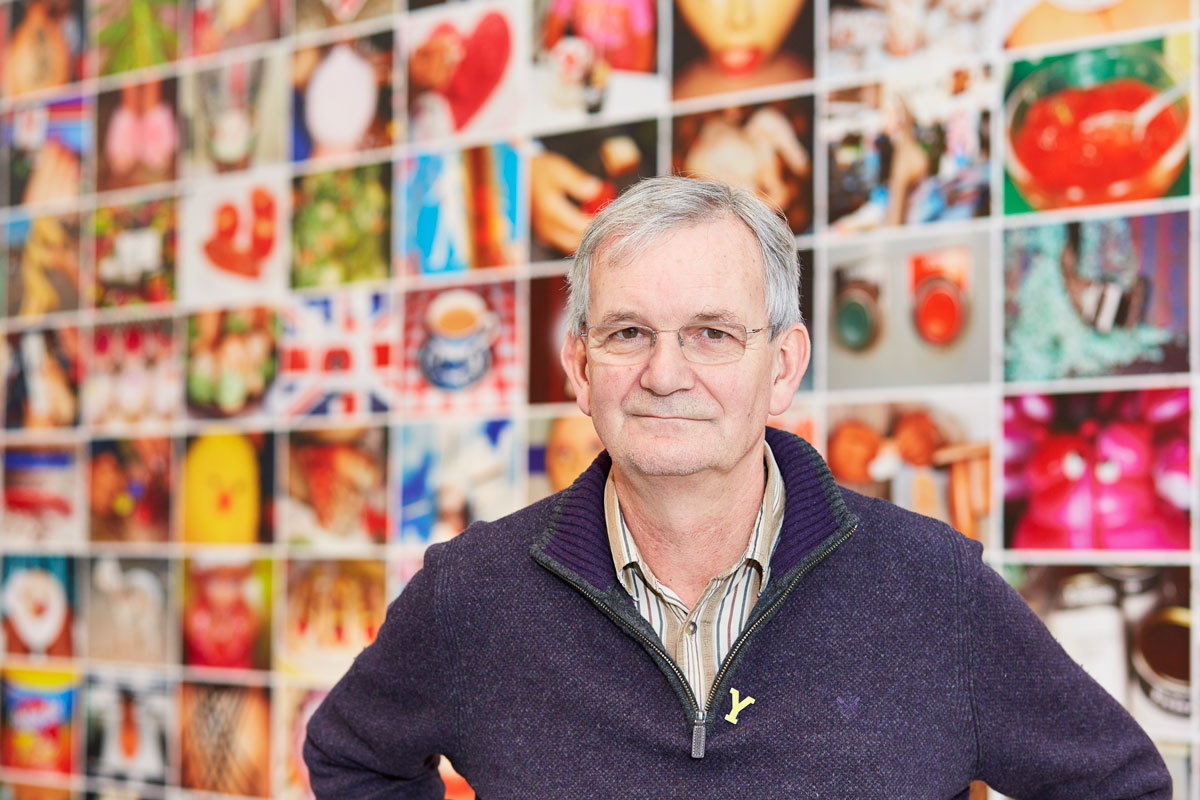“Life is weird. If only we could see it,” Martin Parr has said before, and it’s Parr’s innate ability to find the odd in the everyday that has set his photography apart. His new exhibition of works at the Hepworth Gallery in Wakefield are no different, essentially focusing on a Yorkshire farming community, but tapping into the weird, unintentionally mystical-sounding world of The Rhubarb Triangle. It all takes place in a small area of the county, where generations have groomed the bright pink, yellow-tipped plant in candlelit sheds, and Parr spent time there, capturing the community’s high priestess (Janet Oldroyd), the sense of religious devotion (to the root), and the quasi-pagan festival (via Wakefield town centre) in honour of all things rhubarb (tarts, crumbles, hard-boiled sweets). Parr has taken an agricultural scene that seems utterly normal to its participants and locals, and thrown fresh light on it.
The show in Wakefield is also a homecoming of sorts, since Parr took many of his first pictures whilst visiting his Grandpa in Yorkshire. Those shots from 70s chapels, luncheons (Parr loves a luncheon), terraces and mills all show his skill as a photographer, but also the outsider eye that would go on to define the rest of his work. There’s much more on show at the Hepworth, making this a near-retrospective: the ongoing Autoportrait series of him in the world’s weirdest, naffest photo studio set-ups; his most legendary series, The Last Resort; the 80s middle-class-curious The Cost of Living; the brilliantly binary Work and Leisure; the colour-popping Common Sense; and lastly an LOL, looping video, Think of England.
What made you want to document the rhubarb triangle?
The whole rhubarb business has changed. It’s had its ups and downs. It went down in the 60s, but it’s recently revived itself, because all the top restaurants favour rhubarb and people regard it as a seasonal product and incorporate it into their menus. It went down and now it’s coming back up.
How long were you there?
I went three or four times during the season to see the different processes and stages of the rhubarb production and growing. It takes six to eight weeks to grow, then it’s over. Of course they phase it, so they have many different crops. I only went for one season for an agreed commission with the Hepworth.
How was the party with the farmers?
They all came and they all got their book and they’re all quite pleased to see it. It was nice to show them the photos blown up big. They probably had no idea the scale that these pictures would be at. I was very pleased that we gave them the VIP treatment. Absolutely rightly so.

Do you try and let your subjects know the significance of the shows they’re going to be in and the places they’re going to be shown?
Not really. You just tell them, like we told them it was for the Hepworth and probably most of them haven’t been to the Hepworth. We got 10 or 12 people into the Hepworth, so that in itself is an achievement. And this weekend is the rhubarb festival, so I imagine there’ll be a lot [going to the gallery] through for that.
Do people think you’re a local snapper, or do they know you’re “Martin Parr”?
I have no idea. I don’t ask them. I send them all the prints if I do a portrait. I’m not going to tell them, “Oh, I’m a famous photographer.” I’m just a guy with a camera who shows up, who’s interested in what they’re doing. So it’s not a question I ask, or even think about. You’re only as good as the time that you’re there. No-one gives a shit who you are. You’re only as good as your engagement when you’re sat there talking to them.
You have the Barbican show coming up, where you’re curating other photographers. Do you enjoy curating?
I seamlessly hop between editing, curating and shooting. I mean shooting is my priority, but I like to do other projects as well and I’ve built up a platform to do that, so this is a great show to be involved in, looking at all the different ways people have perceived Britain, since around the war and up to now. It’s a fascinating show and people are always interested to see how other people see us. It’s all foreign photographers.
Who might we be surprised by?
There are some people we’re quite familiar with, like Cartier-Bresson, Bruce Davidson, and we’ve got some real gems of people who are surprising, like Okamura from Japan. The two Japanese are quite brilliant and totally unknown. We have an Italian called Butturini who did a book on London in the 60s that no-one has seen. There’ll be plenty of surprises and some reassuringly familiar names.

You mentioned Cartier-Bresson. He was once the President of Magnum, and now you are.
It’s usually a three or four year slot. It’s not defined. It’s not like the American Presidency, so I’ll probably do another 18 months or so and then pass onto someone else.
What do you think you’ve gained from that?
Well I was part of the machinery, in fact I led the search for a new CEO, who’s been very dynamic, very effective. We’re really trying to modernise and change the managerial systems within Magnum and we’re doing quite well. I’m very positive about the future.
Why did it need modernising?
Because agencies and photography are changing so constantly that you have to prepare for what’s next, rather than keeping up with the past. I’m in touch with the CEO regularly. We do three or four calls a week. I’m the bridge between the photographers and the staff.
You’re an avid collector of things like trays and Margaret Thatcher memorabilia. What’s your latest collecting obsession?
I’m doing Martin Luther King at the moment. It’s interesting to see all the ephemera that was created around his death and since then. He’s an icon, so there’s a lot of things produced. Same with the space dogs. It’s all on eBay. I’m an eBay junkie! It’s a natural habit that I have. It’s an obsession really.

How much research goes into all of your projects?
I just knew that the Triangle would be an interesting topic. You have to do production and research and then you find out on the job as things unfold in front of you. You have variants. Some things are more successful than others, inevitably. Like your articles: some are better than others.
You’ve got a knack of naming your series…
They just happen naturally really. No pressure. The Rhubarb Triangle just named itself. How can you fail?
What would you say are your main skills in getting the shot?
I’m not going to tell you about my skills. I’m an English person! We don’t talk ourselves up. I’m not American. C’mon! We have to be self-deprecating. I’m not going to confess to any skills whatsoever. That’s your job, if you want to. No pressure!
Credits
Text Stuart Brumfitt
All images courtesy Martin Parr and The Hepworth Wakefield/hepworthwakefield.org
